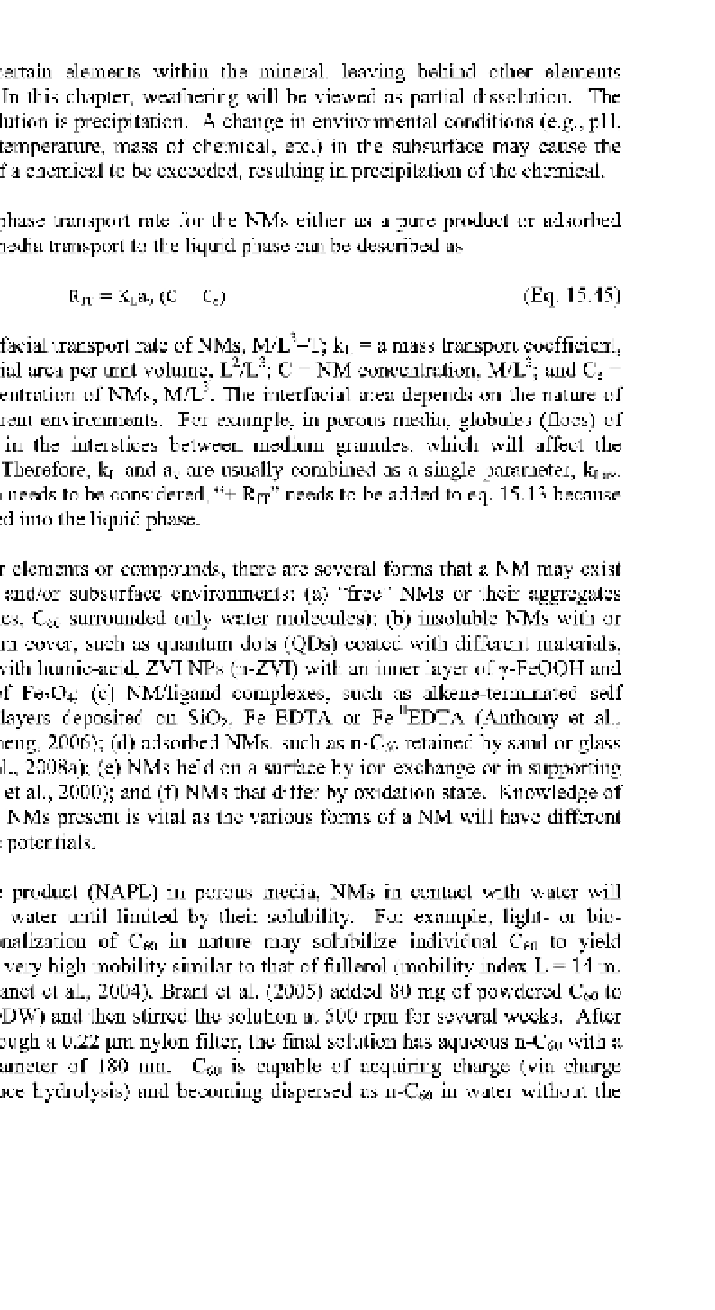Environmental Engineering Reference
In-Depth Information
solubilizing of certain elements within the mineral, leaving behind other elements
(USEPA, 1989). In this chapter, weathering will be viewed as partial dissolution. The
opposite of dissolution is precipitation. A change in environmental conditions (e.g., pH,
redox potential, temperature, mass of chemical, etc.) in the subsurface may cause the
saturation limit of a chemical to be exceeded, resulting in precipitation of the chemical.
The interphase transport rate for the NMs either as a pure product or adsorbed
onto the porous media transport to the liquid phase can be described as
R
I
T
= K
L
a
v
(C - C
e
) (Eq. 15.45)
where RIT = interfacial transport rate of NMs, M/L
3
-T; ]JL = a mass transport coefficient,
L/T; a
v
= interfacial area per unit volume, L
2
/L
3
; C = NM concentration, M/L
3
; and C
e
=
equilibrium concentration of NMs, M/L
3
. The interfacial area depends on the nature of
the NMs in different environments. For example, in porous media, globules (floes) of
NMs may exist in the interstices between medium granules, which will affect the
interfacial area. Therefore, ]JL and a
v
are usually combined as a single parameter, ki^v
When dissolution needs to be considered, "+ RIT" needs to be added to eq. 15.13 because
the NMs are added into the liquid phase.
Like other elements or compounds, there are several forms that a NM may exist
in surface water and/or subsurface environments: (a) "free" NMs or their aggregates
(e.g., clay particles, Ceo surrounded only water molecules); (b) insoluble NMs with or
without a thin-film cover, such as quantum dots (QDs) coated with different materials,
hematite coated with humic-acid, ZVI NPs (n-ZVI) with an inner layer of y-FeOOH and
an outer layer of FesCU; (c) NM/ligand complexes, such as alkene-terminated self
assembled monolayers deposited on SiC>2, Fe
n
EDTA or Fe
m
EDTA (Anthony et al.,
2006; Joo and Cheng, 2006); (d) adsorbed NMs, such as n-Ceo retained by sand or glass
beads (Wang et al., 2008a); (e) NMs held on a surface by ion exchange or in supporting
matrixes (Ponder et al., 2000); and (f) NMs that differ by oxidation state. Knowledge of
the form of these NMs present is vital as the various forms of a NM will have different
transport and fate potentials.
Like pure product (NAPL) in porous media, NMs in contact with water will
dissolve into the water until limited by their solubility. For example, light- or bio-
activated functionalization of Ceo in nature may solubilize individual Ceo to yield
molecules with a very high mobility similar to that of fullerol (mobility index L = 14m,
Table 15.5, Lecoanet et al., 2004). Brant et al. (2005) added 80 mg of powdered C
6
0
to
100 mL water (DDW) and then stirred the solution at 500 rpm for several weeks. After
being filtered through a 0.22 |im nylon filter, the final solution has aqueous n-Ceo with a
mean particle diameter of 180 nm. Ceo is capable of acquiring charge (via charge
transfer and surface hydrolysis) and becoming dispersed as n-Ceo in water without the

Search WWH ::

Custom Search